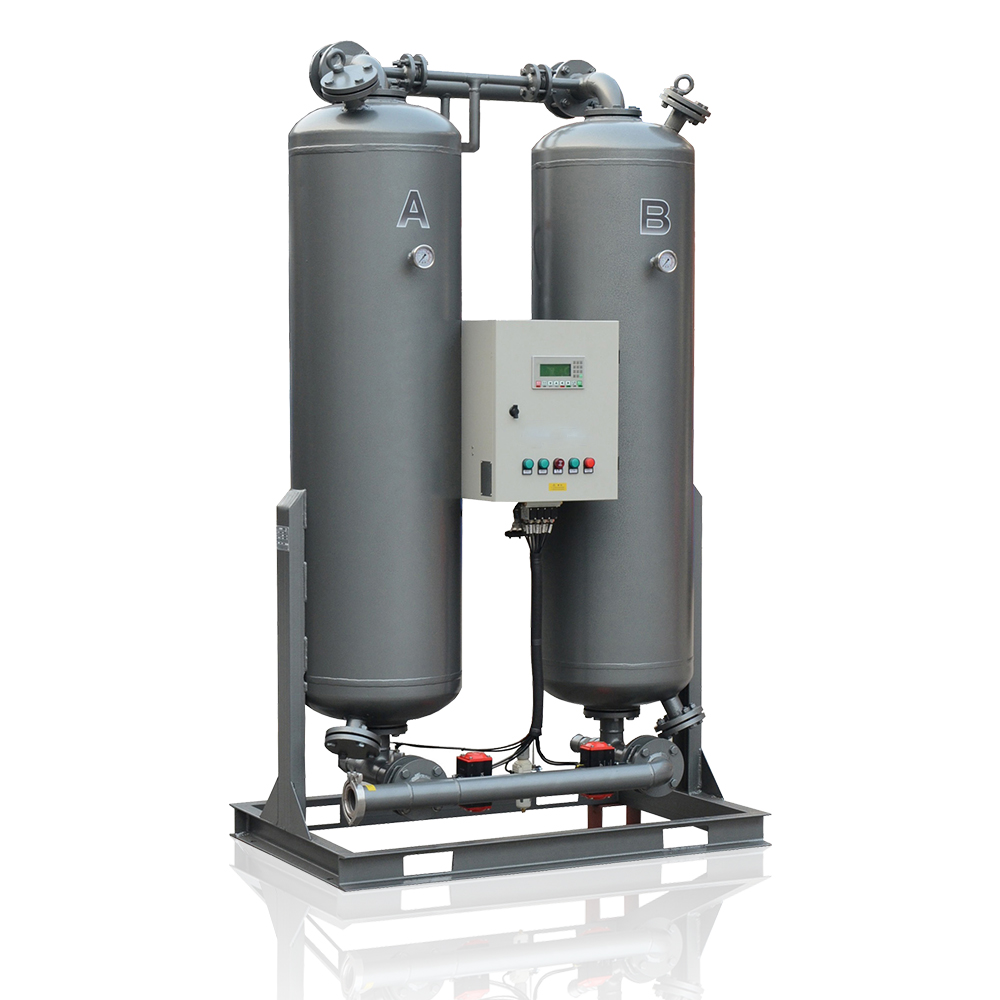| Availability: | |
|---|---|
| Quantity: | |
Heatless adsorption dryers (heatless regenerative adsorption dryers) use the pressure swing adsorption (PSA) principle to remove moisture from compressed air using adsorbents (such as molecular sieves and activated alumina) and restore the adsorbent's drying capacity through heatless regeneration.

Product features
1. Energy-efficient and highly efficient, with low operating costs
2. Simple structure and easy maintenance
3. Stable ultra-low dew point
4. Oil-free and pollution-free
5. Long-life adsorbent
6. Adaptable to high load fluctuations
Technical Parameters
| SXD Series Heatless desiccant air dryer | ||||||
| Model | Air Delivery (m3/min) | Voltage (V/HZ) | Power (kW) | Inlet/Outlet (PT) | Dimension (mm) | Weight (Kg) |
| L*W*H | ||||||
| SXD-80 | 85 | 220V/50HZ | 0.2 | DN125 | 2420*1550*2800 | 3520 |
| SXD-100 | 110 | 220V/50HZ | 0.2 | DN150 | 2500*1650*2800 | 4320 |
| SXD-120 | 130 | 220V/50HZ | 0.2 | DN150 | 2650*1650*2800 | 4750 |
| SXD-150 | 155 | 220V/50HZ | 0.2 | DN200 | 2800*1700*2900 | 5260 |
Main Applications
Oil & Gas: Instrument air for explosion-proof environments
Power & Chemical: High-purity compressed air requirements
Railway & Marine: Environments with unstable power supply
Laboratories & Precision Manufacturing: Ultra-low dew point requirements
FAQ
Q1. How does a heatless adsorption dryer work?
A. Principle: It uses a dual-tower pressure swing adsorption (PSA) system: While one tower adsorbs moisture, the other tower purges and regenerates the adsorbent (molecular sieve/alumina) with a small amount of dry air (approximately 12-15%).
Cycling: The dual-tower operating state is automatically switched (adsorption tower → regeneration tower) every 4-10 minutes, ensuring continuous air supply.
Q2. Is 15% regeneration air consumption a waste? How can it be reduced?
A. Necessity: Regeneration air consumption is an inherent characteristic of physical adsorption and is used to remove moisture from the adsorption tower.
Optimization Method: Optimize the model to match actual air consumption.
Install a dew point energy-saving control system: Automatically adjust regeneration air consumption based on humidity (reducing it to 8-10%).
Q3. What causes a sudden increase in outlet dew point (e.g., -20°C to 0°C)?
A. Adsorbent failure, adsorbent pulverization, valve leakage, or incomplete regeneration.
Q4. Does a heatless adsorption dryer require a power source?
A. Only control power is required: to drive the solenoid valve and controller (power <100W), no high-power electricity is required (unlike micro-heating types).
Q5. Which industries require heatless adsorption dryers?
A. Semiconductor manufacturing, medical ventilators, lithium battery coating, and food packaging.
Q6. What precautions should be taken when restarting after a shutdown?
A. Adsorbent regeneration: If the system has been down for >48 hours, the regeneration process must be manually initiated to prevent wet adsorbent from clumping.
Gradual loading: Start with a low flow rate for 10 minutes, then gradually increase the load.
Heatless adsorption dryers (heatless regenerative adsorption dryers) use the pressure swing adsorption (PSA) principle to remove moisture from compressed air using adsorbents (such as molecular sieves and activated alumina) and restore the adsorbent's drying capacity through heatless regeneration.

Product features
1. Energy-efficient and highly efficient, with low operating costs
2. Simple structure and easy maintenance
3. Stable ultra-low dew point
4. Oil-free and pollution-free
5. Long-life adsorbent
6. Adaptable to high load fluctuations
Technical Parameters
| SXD Series Heatless desiccant air dryer | ||||||
| Model | Air Delivery (m3/min) | Voltage (V/HZ) | Power (kW) | Inlet/Outlet (PT) | Dimension (mm) | Weight (Kg) |
| L*W*H | ||||||
| SXD-80 | 85 | 220V/50HZ | 0.2 | DN125 | 2420*1550*2800 | 3520 |
| SXD-100 | 110 | 220V/50HZ | 0.2 | DN150 | 2500*1650*2800 | 4320 |
| SXD-120 | 130 | 220V/50HZ | 0.2 | DN150 | 2650*1650*2800 | 4750 |
| SXD-150 | 155 | 220V/50HZ | 0.2 | DN200 | 2800*1700*2900 | 5260 |
Main Applications
Oil & Gas: Instrument air for explosion-proof environments
Power & Chemical: High-purity compressed air requirements
Railway & Marine: Environments with unstable power supply
Laboratories & Precision Manufacturing: Ultra-low dew point requirements
FAQ
Q1. How does a heatless adsorption dryer work?
A. Principle: It uses a dual-tower pressure swing adsorption (PSA) system: While one tower adsorbs moisture, the other tower purges and regenerates the adsorbent (molecular sieve/alumina) with a small amount of dry air (approximately 12-15%).
Cycling: The dual-tower operating state is automatically switched (adsorption tower → regeneration tower) every 4-10 minutes, ensuring continuous air supply.
Q2. Is 15% regeneration air consumption a waste? How can it be reduced?
A. Necessity: Regeneration air consumption is an inherent characteristic of physical adsorption and is used to remove moisture from the adsorption tower.
Optimization Method: Optimize the model to match actual air consumption.
Install a dew point energy-saving control system: Automatically adjust regeneration air consumption based on humidity (reducing it to 8-10%).
Q3. What causes a sudden increase in outlet dew point (e.g., -20°C to 0°C)?
A. Adsorbent failure, adsorbent pulverization, valve leakage, or incomplete regeneration.
Q4. Does a heatless adsorption dryer require a power source?
A. Only control power is required: to drive the solenoid valve and controller (power <100W), no high-power electricity is required (unlike micro-heating types).
Q5. Which industries require heatless adsorption dryers?
A. Semiconductor manufacturing, medical ventilators, lithium battery coating, and food packaging.
Q6. What precautions should be taken when restarting after a shutdown?
A. Adsorbent regeneration: If the system has been down for >48 hours, the regeneration process must be manually initiated to prevent wet adsorbent from clumping.
Gradual loading: Start with a low flow rate for 10 minutes, then gradually increase the load.